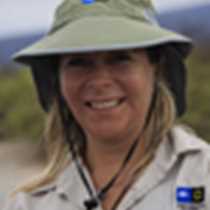Southern Isabela Island
Once the National Geographic Islander had moved down towards the southern tip of Isabela, we had our first morning outing. We made a wet landing to take a fabulous long walk along a loop trail at Urbina Bay. This is an exceptional and absolutely fascinating site. Urbina Bay is an uplifted area. In 1954, more than thirty square kilometers of lava rock and a huge white coral reef were uplifted from the ocean floor towards the surface. Shifting and pressure from molten lava rock pushed up the coast and, according to scientists, in a period of only a few hours, rocks and corals were uplifted by as much as twelve feet.
We explored this uplifted area for about two and a half hours, finding yellow land iguanas along the trail. Several male iguanas were observed; they were warming up as they patrolled their territory. The land iguanas at Urbina Bay are exceptionally large and bright yellow. They are strong and sturdy and it was interesting that no females or young were observed today. Near the end of our hike, we spotted two adult Galápagos hawks. They were flying and calling near a spot where they nest year after year. Soon a pair will be building a large nest and we will share the joy of watching their offspring week after week as they grow into beautiful young hawks that will leave the nest after a few months.
After we completed the long loop trail or the short walk, we arrived at the beach where we had disembarked and we swam in the company of Galápagos penguins! This was such a treat! After hiking that superb trail, we were playing with penguins at the beach. And we were literally playing with them, since these were a couple of very curious ones. They swam among us and circled around us and it was an absolute delight!
After lunch, our Expedition Leader gave a presentation on Charles Darwin, his life, his research and his theory of evolution. As soon as she had finished we had our second outing for the day. We were anchored at Punta Moreno which is a rocky area at the base of Sierra Negra and Cerro Azul volcanoes. We crossed a broken lava field and enjoyed finding a brackish lagoon; a sort of an oasis in the midst of miles of lava, where three pink flamingoes, white-cheeked pintail ducks and common stilts were feeding. The wind was blowing really hard and our hike was a good work as we fought to hike against it.
Once our Zodiac drivers picked us up after the rocky walk, and for the last time they took us to observe the flightless cormorants, the Galápagos penguins and the extremely large and fat marine iguanas sitting on the rocky shores of Punta Moreno.
This was another full day in paradise!
Once the National Geographic Islander had moved down towards the southern tip of Isabela, we had our first morning outing. We made a wet landing to take a fabulous long walk along a loop trail at Urbina Bay. This is an exceptional and absolutely fascinating site. Urbina Bay is an uplifted area. In 1954, more than thirty square kilometers of lava rock and a huge white coral reef were uplifted from the ocean floor towards the surface. Shifting and pressure from molten lava rock pushed up the coast and, according to scientists, in a period of only a few hours, rocks and corals were uplifted by as much as twelve feet.
We explored this uplifted area for about two and a half hours, finding yellow land iguanas along the trail. Several male iguanas were observed; they were warming up as they patrolled their territory. The land iguanas at Urbina Bay are exceptionally large and bright yellow. They are strong and sturdy and it was interesting that no females or young were observed today. Near the end of our hike, we spotted two adult Galápagos hawks. They were flying and calling near a spot where they nest year after year. Soon a pair will be building a large nest and we will share the joy of watching their offspring week after week as they grow into beautiful young hawks that will leave the nest after a few months.
After we completed the long loop trail or the short walk, we arrived at the beach where we had disembarked and we swam in the company of Galápagos penguins! This was such a treat! After hiking that superb trail, we were playing with penguins at the beach. And we were literally playing with them, since these were a couple of very curious ones. They swam among us and circled around us and it was an absolute delight!
After lunch, our Expedition Leader gave a presentation on Charles Darwin, his life, his research and his theory of evolution. As soon as she had finished we had our second outing for the day. We were anchored at Punta Moreno which is a rocky area at the base of Sierra Negra and Cerro Azul volcanoes. We crossed a broken lava field and enjoyed finding a brackish lagoon; a sort of an oasis in the midst of miles of lava, where three pink flamingoes, white-cheeked pintail ducks and common stilts were feeding. The wind was blowing really hard and our hike was a good work as we fought to hike against it.
Once our Zodiac drivers picked us up after the rocky walk, and for the last time they took us to observe the flightless cormorants, the Galápagos penguins and the extremely large and fat marine iguanas sitting on the rocky shores of Punta Moreno.
This was another full day in paradise!




